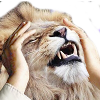
A rare look at the world’s most expensive sheep
In Senegal, Ladoum sheep can cost tens of thousands of dollars. Measuring up to four feet tall, they're prized as pets and status symbols.Assane Dieye, manager of a flock of Ladoum sheep, shows off a ram named Ballon d’Or, which translates to “golden ball” in French. The portraits were taken by Cherkaoui in his mobile studio.
PHOTOGRAPHS BYSYLVAIN CHERKAOUI, PANOS PICTURES/REDUX
TEXT BYDOUGLAS MAIN
PUBLISHED DECEMBER 8, 2022
• 5 MIN READ
Sheep are usually raised for their wool, and sometimes their meat. But in Senegal, some of these animals are prized as expensive pets—and even compete in beauty pageants.
Photographer Sylvain Cherkaoui first learned about the creatures, known as Ladoum sheep, while hunkered down at his home in Dakar during the early part of the COVID-19 pandemic. He saw the sheep depicted on billboards, including one that read: “Buy a car and we’ll give you a sheep!”

Fatoumata Doumbia poses with her sheep Le Ladoum Mass, a ram that’s a little over two years old and measures 3.5 feet in height. The breed’s tall stature is part of the reason for their appeal.


Left: Habibou Diop shows off a 19-month-old lamb named Bideo Bou Bess.
Right: Madame Wane Fatou Binetou Diop and her brother Moustapha Diop pose with their ram, known as Mapate Junior, who is two and a half years old.
But the animals in these advertisements were majestic and large, unlike the smaller, more drab sheep that are common in Senegal. These regular sheep are often sacrificed by the majority Muslim population on the holiday feast of Eid al-Fitr.
Cherkaoui began to learn more about Ladoum sheep, which originated around the 1970s as a hybrid between a Mauritanian and a Malian breed. Known for their good looks, tall stature, prominent muzzles, and curved horns, they can weigh up to 400 pounds and measure four feet in height. The sheep, which are raised by a select number of breeders, are in high demand: Wealthy Senegalese often pay $10,000, and sometimes significantly more, for a single animal, with records going up to $80,000, Cherkaoui says.
“I often say that Ladoums are the Rolex of sheeps: Owning a Ladoum looks expensive, luxurious,” he says by email.

The price of each animal (above, a two-year-old ram, Sherif) is determined by factors such as the shape and symmetry of the horns.


Left: Sherif stands next to owner Seydi Gadiaga, who runs the Keur Mame Seydi flock. Ladoum sheep are a cross between a Mauritanian and Malian breed.
Right: Madame Sow Fatoumata Ka with Amath, a two-year-old Ladoum ram. Unlike other sheep, these animals are often not sacrificed for the Muslim holiday feast of Eid al-Fitr, owing to their value and how much people care for them.
The price can vary according to the “size and weight of the sheep, the shape and symmetry of the horns, the curve of the muzzle, and the size and symmetry of the testicles,” he adds. Rams are often more valued than ewes, though of course both are necessary for breeding the animals, which can prove to be a lucrative enterprise.
Many of these owners enter their animals into sheep beauty pageants, aired annually on Senegalese television. The winner gets a prize of food and cash—and their sheep becomes much more valuable, should they choose to sell it.
“The beauty criteria [varies] based on the appearance of the winner of the last competition.”
Intrigued by the Ladoum phenomenon, Cherkaoui created a portrait series to celebrate the animals and their owners.
“When I explained my exhibition project [to people] and that I was going to put their Ladoums under the spotlight, they felt proud and valued,” he says.
Sylvain Cherkaoui is a French photographer based in Dakar who focuses on news from West Africa.


